Chapter: Medical Physiology: Urine Formation by the Kidneys: II. Tubular Processing of the Glomerular Filtrate
Use of Clearance Methods to Quantify Kidney Function
Use of Clearance Methods to Quantify Kidney Function
The rates at which different substances are “cleared” from the plasma provide a useful way of quantitating the effectiveness with which the kidneys excrete various substances (Table 27–4). By definition, therenal clearance of a substance is the volume of plasma that is completely cleared of the substance by the kidneys per unit time. This concept is somewhatabstract because there is no single volume of plasma that is completely cleared of a substance. However, renal clearance provides a useful way of quantifying the excretory function of the kidneys and, as discussed later, can be used to quantify the rate at which blood flows through the kidneys as well as the basic functions of the kidneys: glomerular filtration, tubular reabsorp-tion, and tubular secretion.
To illustrate the clearance principle, consider the fol-lowing example: If the plasma passing through the kidneys contains 1 milligram of a substance in each mil-liliter and if 1 milligram of this substance is also excreted into the urine each minute, then 1 ml/min of the plasma is “cleared” of the substance. Thus,
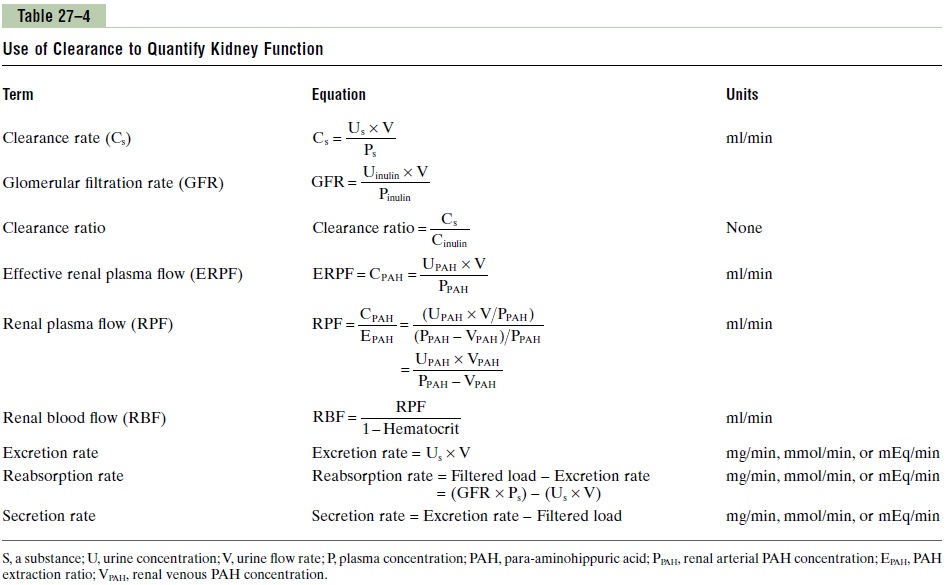
clearance refers to the volume of plasma that would be necessary to supply the amount of substance excreted in the urine per unit time. Stated mathematically,
Cs x Ps = Us x V,
where Cs is the clearance rate of a substance s, Ps is the plasma concentration of the substance, Us is the urine concentration of that substance, and V is the urine flow rate. Rearranging this equation, clearance can be expressed as

Thus, renal clearance of a substance is calculated from the urinary excretion rate (Us x V) of that substance divided by its plasma concentration.
Inulin Clearance Can Be Used to Estimate GFR
If a substance is freely filtered (filtered as freely as water) and is not reabsorbed or secreted by the renal tubules, then the rate at which that substance is excreted in the urine (Us x V) is equal to the filtration rate of the substance by the kidneys (GFR x Ps). Thus,
GFR x Ps = Us x V
The GFR, therefore, can be calculated as the clearance of the substance as follows:

A substance that fits these criteria is inulin, a polysac-charide molecule with a molecular weight of about 5200. Inulin, which is not produced in the body, is found in the roots of certain plants and must be administered intravenously to a patient to measure GFR.
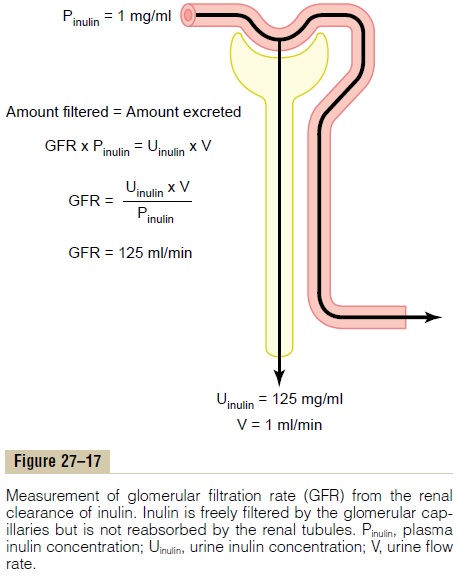
Figure 27–17 shows the renal handling of inulin. In this example, the plasma concentration is 1 mg/ml, urine concentration is 125 mg/ml, and urine flow rate is 1 ml/ min. Therefore, 125 mg/min of inulin passes into the urine. Then, inulin clearance is calculated as the urine excretion rate of inulin divided by the plasma concen-tration, which yields a value of 125 ml/min. Thus, 125 milliliters of plasma flowing through the kidneys must be filtered to deliver the inulin that appears in the urine.
Inulin is not the only substance that can be used for determining GFR. Other substances that have been used clinically to estimate GFR include radioactiveiothalamate and creatinine.
Creatinine Clearance and Plasma Creatinine Concentration Can Be Used to Estimate GFR
Creatinine is a by-product of muscle metabolism and is cleared from the body fluids almost entirely by glomeru-lar filtration. Therefore, the clearance of creatinine can also be used to assess GFR. Because measurement of creatinine clearance does not require intravenous infu-sion into the patient, this method is much more widely used than inulin clearance for estimating GFR clinically. However, creatinine clearance is not a perfect marker of GFR because a small amount of it is secreted by the tubules, so that the amount of creatinine excreted slightly exceeds the amount filtered. There is normally a slight error in measuring plasma creatinine that leads to an overestimate of the plasma creatinine concentration, and fortuitously, these two errors tend to vides a reasonable estimate of GFR.
In some cases, it may not be practical to collect urine in a patient for measuring creatinine clearance (CCr). An obtained by simply measuring plasma creatinine con- centration (PCr), which is inversely proportional to GFR:

If GFR suddenly decreases by 50%, the kidneys will transiently filter and excrete only half as much creati-nine, causing accumulation of creatinine in the body fluids and raising plasma concentration. Plasma con-centration of creatinine will continue to rise until the fil-tered load of creatinine (PCr x GFR) and creatinine excretion (UCr x V) return to normal and a balance between creatinine production and creatinine excretion is reestablished. This will occur when plasma creatinine increases to approximately twice normal, as shown in Figure 27–18. If GFR falls to one-fourth normal, plasma creatinine would increase to about 4 times normal, and a decrease of GFR to one-eighth normal would raise plasma creatinine to 8 times normal. Thus, under steady-state conditions, the creatinine excretion rate equals the rate of creatinine production, despite reductions in GFR. However, this normal rate of creatinine excretion occurs at the expense of elevated plasma creatinine con-centration, as shown in Figure 27–19.
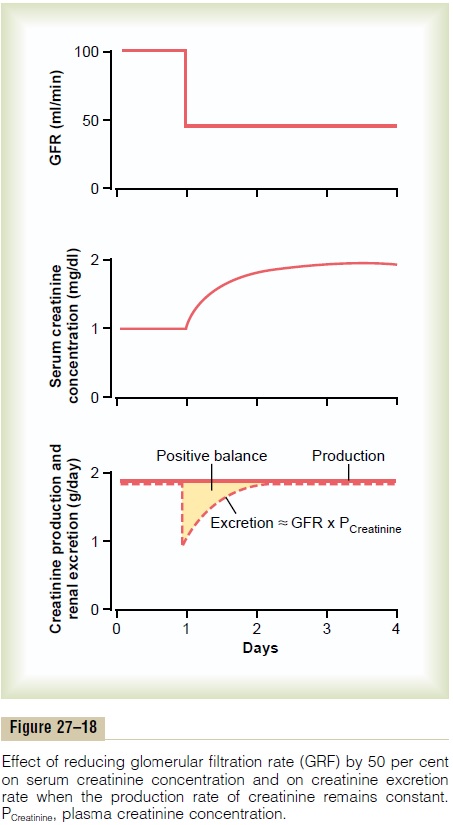
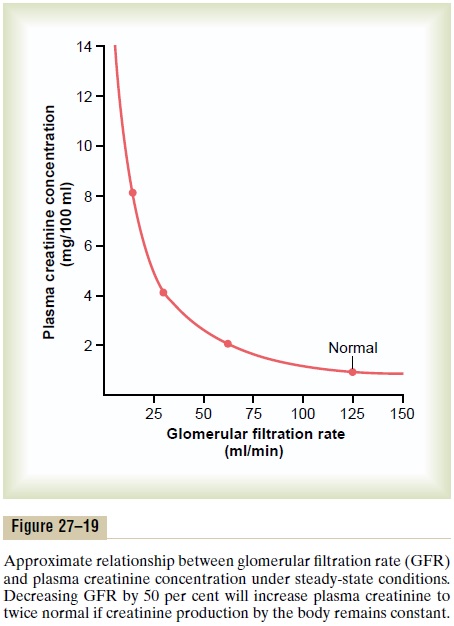
PAH Clearance Can Be Used to Estimate Renal Plasma Flow
Theoretically, if a substance is completely cleared from the plasma, the clearance rate of that substance is equal to the total renal plasma flow. In other words, the amount of the substance delivered to the kidneys in the blood (renal plasma flow x Ps) would be equal to the amount excreted in the urine (Us x V). Thus, renal plasma flow (RPF) could be calculated as

Because the GFR is only about 20 per cent of the total plasma flow, a substance that is completely cleared from the plasma must be excreted by tubular secretion as well as glomerular filtration (Figure 27–20). There is no known substance that is completely cleared by the kidneys. One substance, however, PAH, is about 90 per cent cleared from the plasma. Therefore, the clearance of PAH can be used as an approximation of renal plasma flow. To be more accurate, one can correct for the percentage of PAH that is still in the blood when it leaves the kidneys. The percentage of PAH removed from the blood is known as the extraction ratio of PAH and averages about 90 per cent in normal kidneys. In diseased kidneys, this extraction ratio may be reduced because of inability of damaged tubules to secrete PAH into the tubular fluid.
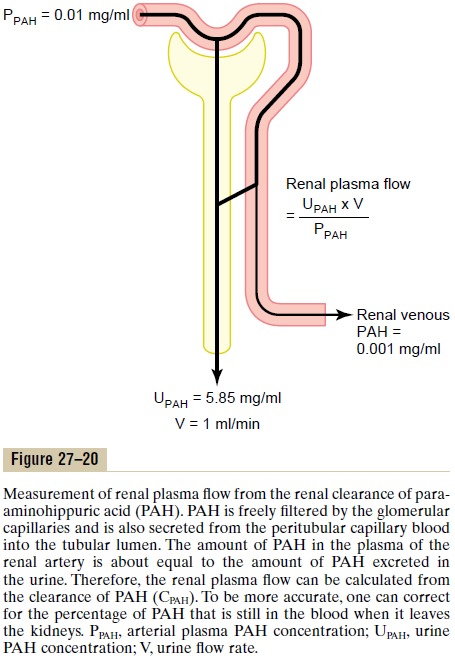
The calculation of RPF can be demonstrated by the following example: Assume that the plasma concentra-tion of PAH is 0.01 mg/ml, urine concentration is 5.85 mg/ml, and urine flow rate is 1 ml/min. PAH clearance can be calculated from the rate of urinary PAH excre-tion (5.85 mg/ml x 1 ml/min) divided by the plasma PAH concentration (0.01 mg/ml). Thus, clearance of PAH cal-culates to be 585 ml/min.
If the extraction ratio for PAH is 90 per cent, the actual renal plasma flow can be calculated by dividing 585 ml/min by 0.9, yielding a value of 650 ml/min. Thus, total renal plasma flow can be calculated as
Total renal plasma flow = Clearance of PAH/Extraction ratio of PAH
The extraction ratio (EPAH) is calculated as the dif-ference between the renal arterial PAH (PPAH) and renal venous PAH (VPAH) concentrations, divided by the renal arterial PAH concentration:

One can calculate the total blood flow through the kidneys from the total renal plasma flow and hematocrit (the percentage of red blood cells in the blood). If the hematocrit is 0.45 and the total renal plasma flow is 650 ml/min, the total blood flow through both kidneys is 650/(1 - 0.45), or 1182 ml/min.
Filtration Fraction Is Calculated from GFR Divided by Renal Plasma Flow
To calculate the filtration fraction, which is the fraction of plasma that filters through the glomerular mem-brane, one must first know the renal plasma flow (PAH clearance) and the GFR (inulin clearance). If renal plasma flow is 650 ml/min and GFR is 125 ml/min, the filtration fraction (FF) is calculated as
FF = GFR/RPF = 125/650 = 0.19
Calculation of Tubular Reabsorption or Secretion from Renal Clearances
If the rates of glomerular filtration and renal excretion of a substance are known, one can calculate whether there is a net reabsorption or a net secretion of that sub-stance by the renal tubules. For example, if the rate of excretion of the substance (Us x V) is less than the fil-tered load of the substance (GFR x Ps), then some of the substance must have been reabsorbed from the renal tubules. Conversely, if the excretion rate of the substance is greater than its filtered load, then the rate at which it appears in the urine represents the sum of the rate of glomerular filtration plus tubular secretion.
The following example demonstrates the calculation of tubular reabsorption. Assume the following labora-tory values for a patient were obtained:
Urine flow rate = 1 ml/min
Urine concentration of sodium (UNa) = 70 mEq/L = 70 mEq/ml
Plasma sodium concentration = 140 mEq/L = 140 mEq/ml
GFR (inulin clearance) = 100 ml/min
In this example, the filtered sodium load is GFR x PNa, or 100 ml/min x 140 mEq/ml = 14,000 mEq/min. Urinary sodium excretion (UNa x urine flow rate) is 70 mEq/min. Therefore, tubular reabsorption of sodium is the differ-ence between the filtered load and urinary excretion, or 14,000 mEq/min - 70 mEq/min = 13,930 mEq/min.
Comparisons of Inulin Clearance with Clearances of Different Solutes. The following generalizations can be made bycomparing the clearance of a substance with the clear-ance of inulin, a measure of GFR: (1) if the clearance rate of the substance equals that of inulin, the substance is only filtered and not reabsorbed or secreted; (2) if the clearance rate of a substance is less than inulin clear-ance, the substance must have been reabsorbed by the nephron tubules; and (3) if the clearance rate of a sub-stance is greater than that of inulin, the substance must be secreted by the nephron tubules. Listed below are the approximate clearance rates for some of the sub-stances normally handled by the kidneys:
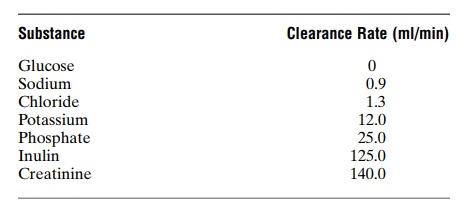
Related Topics